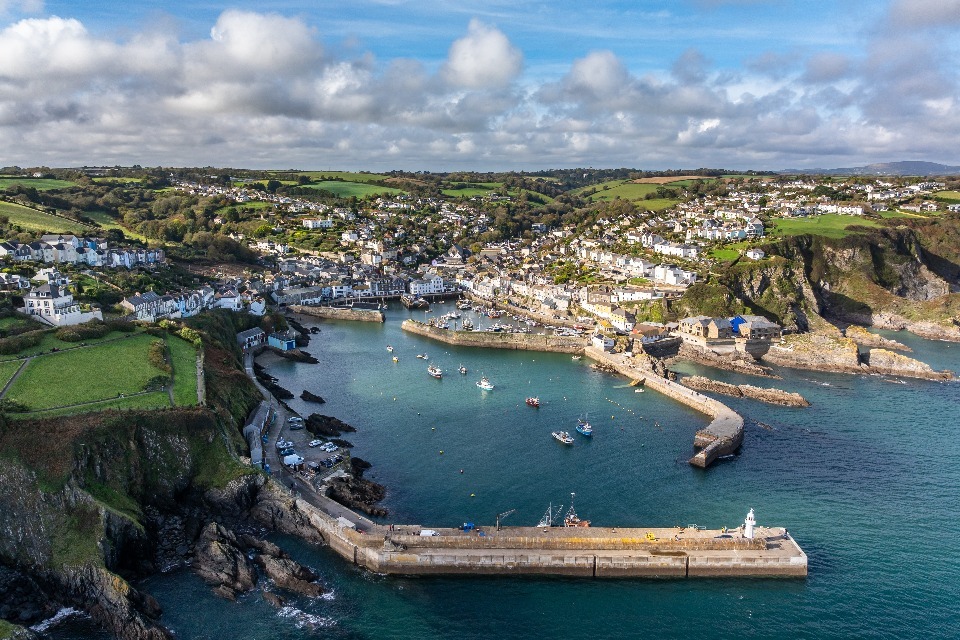- 228 miles of footpath heading west from St Agnes and all along the south coast now improved.
- The footpath follows the South West Coast Path for much of its length but with a number of improvements where the path has been moved nearer to the sea.
- The project creates new access rights between the path and low water.
- New provision for the path to be easily moved following coastal erosion events.
These works form part of a national programme to create a coastal path around the whole of England. Once completed, this will be the longest managed coastal walking route in the world and the UK’s longest National Trail.
Earlier this year the 75-mile stretch from Marsland Mouth on the North Cornwall coast down to Newquay was completed. This follows the route of the existing South West Coast Path (SWCP) National Trail. Now the remaining 228 miles of path are completed heading west from Newquay, down to Land’s End and back along the south coast to Cremyll on the banks of the Tamar.
Plenty to see along the path
For anyone walking the path, there is plenty to see, with towns and villages such as Falmouth, Penzance and Polperro, along with popular spots such as Land’s End and The Lizard.
For those interested in the county’s heritage, there are castles in abundance, like St Mawes and St Michael’s Mount, alongside remnants of Cornwall’s industrial past at Botallack engine houses and the Levant mine and beam engine – to say nothing of the famous cliffside Minack Theatre.
There’s also plenty for lovers of wildlife to spot, including choughs, grey seals and peregrine falcons. And, of course, there are glorious sandy beaches to stop off at throughout the route.
Lining up the path with the coast
In establishing the new trail, Natural England sought to improve the alignment of the coast path where possible or move it closer to the sea. For example, a new route has been created on the western side of the Lizard at Porthkerris instead of the old inland route along country roads. And at Millendreath the new path has been moved away from the road to allow for more scenic views and a safer walking route. Other changes include Downderry where the main route is impassable during high tides, so an alternative follows the coastal road.
While walkers will still encounter steep climbs and descents – as well as gently undulating walking along the cliff tops – there are now more accessible areas. This includes the path between Swanpool and Gyllanvase Beach and the path around Tregantle Fort. Another change is a new legal provision for the trail to ‘roll back’ in response to coastal erosion, thereby securing people’s rights into the future and protecting the investment being made now.
‘Wowing visitors for years’
Andrea Ayres, deputy area director for Natural England, said
This huge stretch of path along two coasts takes in some of the best views in the South West. These much-loved places have been wowing visitors for many years, as well as being loved by local residents.
We hope the improvements to the path, and the additional access rights, will mean even more people will get out and enjoy nature.
This will provide vital health and wellbeing benefits for local communities, as well attracting visitors to the county, with tourism playing a vital role in the South West economy.
‘Great to see sections of the King’s coast path open in Cornwall’
While much of Cornwall’s 300-mile section of the South West Coast Path is owned by private landowners and organisations, the path is managed by Cornwall Council. The council and Cormac, together with the National Trust, have worked to deliver the improvements around the county.
Julian Gray, director, South West Coast Path Association (SWCPA), said
It’s great to see the final sections of the King Charles III England Coast Path open in Cornwall, which creates new open access rights around the coast to help connect people to nature.
The establishment of the KCIIIECP has brought significant investment and improvements to the route of the coast path and also gives us new powers to manage the National Trail in the face of coastal erosion.
We will continue to work with our trail partners to protect, improve and champion the South West Coast Path as one of the world’s great trails.
Local locations used in The Salt Path
The Salt Path, starring Gillian Anderson and Jason Isaacs, was released last week and partly filmed in Newquay, as well as Whitsand Bay and Rame Head on the south east coast of Cornwall. Based on the memoir written by Raynor Winn, the story is about one couple’s walk around the South West Coast Path and could lead to the area attracting a whole new wave of visitors.
The King Charles III England Coast Path (KCIIIECP) is a National Trail around the entire coast of England. Existing coastal national trails will retain their branding and alongside other promoted routes form part of the KCIIIECP.
You can plan your walk on the KCIIIECP, which follows the enhanced route of the SWCP between Newquay and Cremyll, by visiting the KCIIIECP or the South West Coast Path pages of the National Trails website.
Background
The Marine and Coastal Access Act 2009 places a duty on the Secretary of State and Natural England to secure a long-distance walking trail around the open coast of England, together with public access rights to a wider area of land along the way for people to enjoy.
Natural England is working at pace to ensure completion of the KCIIIECP. 1,400 miles were open by the end of 2024.Subject to resources we expect to complete the KCIIIECP by spring 2026.
- To plan their visit walkers can access route maps of all opened sections of the King Charles III England Coast Path and any local diversions on the National Trails website and check for any restrictions to access at Natural England’s open access maps.
- You can promote your business, service, event or place of interest for free on the National Trails website, inspire people to spend more time in your area and benefit from the economic impact of visitors.
- National Trails, marked by the acorn symbol, pass through spectacular scenery, support local tourism and offer a range of routes from short circular walks to long distance challenges.
King Charles III England Coast Path
- Here is a map showing progress to complete the King Charles III England Coast Path.
- The King Charles III England Coast Path will be our longest, National Trail, passing through some of our finest countryside, maritime and industrial heritage, coastal settlements and rural locations.
- It will also be the world’s longest managed coastal trail (i.e. the trail is maintained to National Trail standards).
- It will secure legal rights of public access for the first time to typical coastal land including foreshore, beaches, dunes and cliffs that lies between the trail and the sea.
Improvements to existing access to the coastline include
- a clear and continuous way-marked walking route along this part of the coast, bringing some sections of the existing coastal footpath closer to the sea and linking some places together for the first time.
- Targeted adjustments to make the trail more accessible for people with reduced mobility, where reasonable.
- Uniquely amongst our National Trails the KCIIIECP may be moved in response to natural coastal changes, through ‘roll back’ if the coastline erodes or slips, solving the long-standing difficulties of maintaining a continuous route along the coast – and making a true coastal path practicable. The legal provision for roll back is proposed to sections of the trail where a need has been foreseen but can be retrospectively applied to other parts of the route if deemed necessary.
- The route of the trail can also be altered through planning proposals and where coastal and flood defence works or habitat creation would impact on the proposed or open route of the KCIIIECP.
- You can find out more about progress near you to create the King Charles III England Coast path.
- We work closely with a broad range of national and regional stakeholders around the country including wildlife trusts, National Trust, RSPB, NFU, CLA, RA, OSS, Environment Agency and local authorities.
The Countryside Code is the official guide on how to enjoy nature and treat both it, and the people who live and work there, with respect.
For landowners
Landowners who have KCIIIECP coastal access rights on their land enjoy the lowest liabilities in England.
About Natural England
Established in 2006, Natural England is the government’s independent adviser on the natural environment. Our work is focused on enhancing England’s wildlife and landscapes and maximising the benefits they bring to the public.
- We establish and care for England’s main wildlife and geological sites, ensuring that over 4,000 National Nature Reserves (NNRs) and Sites of Special Scientific Interest are looked after and improved.
- We work to ensure that England’s landscapes are effectively protected, designating England’s National Parks and National Landscapes , and advising widely on their conservation.
- We run Environmental Stewardship and other green farming schemes that deliver over £400 million a year to farmers and landowners, enabling them to enhance the natural environment across two thirds of England’s farmland.
- We fund, manage, and provide scientific expertise for hundreds of conservation projects each year, improving the prospects for thousands of England’s species and habitats.
- We promote access to the wider countryside, helping establish National Trails and coastal trails and ensuring that the public can enjoy and benefit from them.
For more information, visit King Charles III England Coast Path improving public access to the coast .
About the South West Coast Path Association
The South West Coast Path Association is a charity (Registered Charity Number 1163422) that works to ensure the South West Coast Path is one of the best walks in the world and protects it for all to enjoy. Supporting the charity helps the South West Coast Path Association to improve the South West Coast Path and keeps the way open to beautiful coastal places.
For more information visit the South West Coast Path Association.









